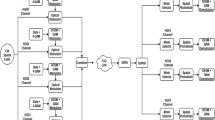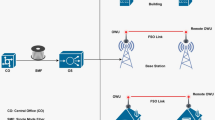Abstract
Free space optical communication (FSO) employs an optical setup to transmit the message signal directly through the air from the source to the receiver. While FSO offers several advantages, its effectiveness for long-distance transmission is hindered by the impact of climate change and pointing error. To address this challenge, this study focuses on improving the efficiency of FSO systems in terms of channel capacity and long-distance communication. To achieve this objective, a 32-channel wavelength division multiplexing (WDM) FSO approach, along with pre- and post-amplification techniques using erbium-doped fiber amplifier (EDFA), and a multiple-input multiple-output (MIMO) technique, have been employed. Furthermore, the proposed framework is evaluated using various modulation schemes, such as gaussian pulse generator (GA), return to zero (RZ), and non-return to zero (NRZ). The proposed system has achieved a channel capacity of 320 Gbps. The proposed system achieves extended transmission ranges: 35 km under clear conditions, 1.37 km under foggy conditions, and 2.53 km under rainy conditions. Furthermore, we formulate a closed-form expression for the bit error rate (BER) in the MIMO FSO system. The performance is evaluated in terms of BER and quality factor (Q Factor). The proposed system outperforms existing designs in terms of transmission range and spectrum efficiency.
















Similar content being viewed by others
Data Availability
Not applicable.
References
Majumdar, A. K. (2015). Advanced Free Space optics (FSO): A Systems Approach. Springer.
Moll, F., Horwath, J., Shrestha, A., Brechtelsbauer, M., Fuchs, C., Navajas, L. A. M., & Díaz González, D. (2015). Demonstration of high-rate laser Communications from a fast Airborne platform. IEEE Journal on Selected Areas in Communications, 33(9), 1985–1995. https://doi.org/10.1109/JSAC.2015.2433054.
Kaushal, H., & Kaddoum, G. (2017). Optical Communication in Space: Challenges and Mitigation techniques. IEEE Communications Surveys and Tutorials, 19(1), 57–96. https://doi.org/10.1109/COMST.2016.2603518.
Seeds, A. J., Shams, H., Fice, M. J., & Renaud, C. C. (2015). TeraHertz photonics for wireless communications. Journal of Lightwave Technology, 33(3), 579–587. https://doi.org/10.1109/JLT.2014.2355137.
Hörack, G., Pezzei, P., Leitgeb, E., & Tischlinger, M. (2016). Alternative Broadband Network Connection for the Last Mile.
Banawan, M., Mishra, S. K., Gouin, A., Bacon, N., Guan, X., Wang, L., & Rusch, L. A. (2023). Using Standard 2×2 MIMO to increase capacity of spatial Multiplexing with OAM Modes. Journal of Lightwave Technology, 41(7), 1974–1984. https://doi.org/10.1109/JLT.2022.3226628.
Sridhar, B., Sridhar, S., & Nanchariah, V. (2022). Performance evaluation of FSO System under Atmospheric turbulence and noise. Journal of the Institution of Engineers (India): Series B, 103(6), 2085–2095. https://doi.org/10.1007/s40031-022-00789-5.
Bhatnagar, M. R., & Ghassemlooy, Z. (2016). Performance analysis of Gamma-Gamma Fading FSO MIMO links with pointing errors. Journal of Lightwave Technology, 34(9), 2158–2169. https://doi.org/10.1109/JLT.2016.2526053.
Nebuloni, R., & Verdugo, E. (2022). FSO path loss model based on the visibility. IEEE Photonics Journal, 14(2), https://doi.org/10.1109/JPHOT.2022.3152728.
Yu, X., Xu, G., Zhang, Q., & Song, Z. (2022). Dual-hop Optical Communication Systems over Málaga Turbulence under pointing error impairments with decode-and-Forward Protocol. IEEE Photonics Journal, 14(6), 1–15. https://doi.org/10.1109/JPHOT.2022.3216283.
Xu, G., Zhang, N., Xu, M., Xu, Z., Zhang, Q., & Song, Z. (2023). Outage probability and average BER of UAV-assisted dual-hop FSO Communication with Amplify-and-Forward relaying. IEEE Transactions on Vehicular Technology, 72(7), 8287–8302. https://doi.org/10.1109/TVT.2023.3252822.
Anuranjana, Kaur, S., Goyal, R., & Chaudhary, S. (2022). 1000 Gbps MDM-WDM FSO link employing DP-QPSK modulation scheme under the effect of fog. Optik, 257(March), 168809. https://doi.org/10.1016/j.ijleo.2022.168809.
Vasani, E., & Shah, V. (2023). Spectrum slicing-based performance analysis of Free Space Optical Communication under Atmospheric Turbulence. Journal of the Institution of Engineers (India): Series B, 104(1), 319–326. https://doi.org/10.1007/s40031-022-00832-5.
Singh, H., Miglani, R., Mittal, N., Gupta, S., Tubbal, F., Raad, R., & Amhoud, E. M. (2023). Designing an optimized free space optical (FSO) link for terrestrial commercial applications under turbulent channel conditions. Optical and Quantum Electronics, 55(6), 532. https://doi.org/10.1007/s11082-023-04805-w.
Vasani, E., & Shah, V. (2023). An Effective Design of Hybrid Spectrum Slicing WDM–PDM in FSO Communication System under different Weather Conditions. Wireless Personal Communications, 130, 777–800. https://doi.org/10.1007/s11277-023-10309-3.
Elsayed, E. E., Kakati, D., Singh, M., Grover, A., & Anand, G. (2022). Design and analysis of a dense wavelength-division multiplexed integrated PON-FSO system using modified OOK/DPPM modulation schemes over atmospheric turbulences. Optical and Quantum Electronics, 54(11), 1–27. https://doi.org/10.1007/s11082-022-04142-4.
Singh, M., Atieh, A., Grover, A., & Barukab, O. (2022). Performance analysis of 40 Gb/s free space optics transmission based on orbital angular momentum multiplexed beams. Alexandria Engineering Journal, 61(7), 5203–5212. https://doi.org/10.1016/j.aej.2021.10.043.
Mesri, L., & Djebbari, A. (2022). Performance limits of FSO based SAC-OCDMA system under Weather Conditions. Journal of Optical Communications, 43(2), 265–272. https://doi.org/10.1515/joc-2018-0204.
Singh, H., Mittal, N., Miglani, R., Singh, H., Gaba, G. S., & Hedabou, M. (2021). Design and analysis of high-speed Free Space Optical (FSO) Communication System for supporting Fifth Generation (5G) data services in diverse geographical locations of India. IEEE Photonics Journal, 13(5), 1–12. https://doi.org/10.1109/JPHOT.2021.3113650.
Shaker, F. K., & Ali, M. A. A. (2021). Multi-Beam Free-Space Optical Link to Mitigation of rain attenuation. Journal of Optical Communications, 42(2), 235–240. https://doi.org/10.1515/joc-2018-0015.
Rani, N., Singh, P., & Kaur, P. (2021). Mitigation of scintillation effects in WDM-FSO system using Homodyne detection. Optik, 248(October 2019), 168165. https://doi.org/10.1016/j.ijleo.2021.168165.
Gupta, Y. K., & Goel, A. (2023). Performance analysis of multiple-beam WDM free space laser-communication system using homodyne detection approach. Heliyon. https://doi.org/10.1016/J.HELIYON.2023.E13325. e13325.
Singh, M., & Malhotra, J. (2019). Performance investigation of high-speed FSO transmission system under the influence of different atmospheric conditions incorporating 3-D orthogonal modulation scheme. Optical and Quantum Electronics, 51(9), https://doi.org/10.1007/s11082-019-1998-2.
Badar, N., Jha, R. K., & Towfeeq, I. (2018). Performance analysis of an 80 (8 × 10) gbps RZ-DPSK based WDM-FSO system under combined effects of various weather conditions and atmospheric turbulence induced fading employing Gamma–Gamma fading model. Optical and Quantum Electronics, 50(1), 1–11. https://doi.org/10.1007/s11082-017-1306-y.
Kim, I. I., McArthur, B., & Korevaar, E. J. (2001). Comparison of laser beam propagation at 785 nm and 1550 nm in fog and haze for optical wireless communications. Optical Wireless Communications III, 4214, 26–37. https://doi.org/10.1117/12.417512.
Soni, G. (2018). Performance analysis of Free Space Optical Link under various attenuation Effects. Science Journal of Circuits Systems and Signal Processing, 7(2), 43. https://doi.org/10.11648/j.cssp.20180702.11.
Kruse, P. W., & McGlauchlin, L. D., R. B. M (1962). Elements of Infrared Technology: Generation, transmission and detection. Wiley.
Saw, B. K., Janyani, V., & Singh, G. (2023). Analysis of coherent-OFDM modulation for FSO communication over distribution with pointing errors. Optics Communications, 545(June), 129677. https://doi.org/10.1016/j.optcom.2023.129677.
Feng, J., & Zhao, X. (2017). Performance analysis of OOK-based FSO systems in Gamma–Gamma turbulence with imprecise channel models. Optics Communications, 402(March), 340–348. https://doi.org/10.1016/j.optcom.2017.06.016.
Adamchikand, V. S., & Marichev, O. I. (1990). The algorithm for calculating integrals of hypergeo- metric type functions and its realization in REDUCE system, 212–224. https://doi.org/10.1145/96877.96930.
Prudnikov, A. P., Brychkov, Y. A., & Mariche, O. I. (1986). Integral and series, more special functions (3 vol.). Gordon and Breach Science Publishers.
Tsiftsis, T. A., Sandalidis, H. G., Karagiannidis, G. K., & Uysal, M. (2009). Optical wireless links with spatial diversity over strong atmospheric turbulence channels. IEEE Transactions on Wireless Communications, 8(2), 951–957. https://doi.org/10.1109/TWC.2009.071318.
Lema, G. G. (2020). Free space optics communication system design using iterative optimization. Journal of Optical Communications, 000010151520200007. https://doi.org/10.1515/joc-2020-0007.
Ghalot, R., Madhu, C., Kaur, G., & Singh, P. (2019). Link estimation of different indian cities under Fog Weather Conditions. Wireless Personal Communications, 105(4), 1215–1234. https://doi.org/10.1007/s11277-019-06142-2.
Chaudhary, S., & Amphawan, A. (2018). Solid core PCF-based mode selector for MDM-Ro-FSO transmission systems. Photonic Network Communications, 36(2), 263–271. https://doi.org/10.1007/s11107-018-0778-4.
Funding
No funding.
Author information
Authors and Affiliations
Contributions
Yogesh Kumar Gupta: Conception and design, Manuscript preparation.Aditya Goel: Supervision and final approval.
Corresponding author
Ethics declarations
Conflict of Interest
Not Applicable.
Ethical Approval
Not Applicable.
Additional information
Publisher’s Note
Springer Nature remains neutral with regard to jurisdictional claims in published maps and institutional affiliations.
Rights and permissions
Springer Nature or its licensor (e.g. a society or other partner) holds exclusive rights to this article under a publishing agreement with the author(s) or other rightsholder(s); author self-archiving of the accepted manuscript version of this article is solely governed by the terms of such publishing agreement and applicable law.
About this article
Cite this article
Gupta, Y.K., Goel, A. EDFA Controlled Spectral Efficient MIMO Free Space Optic Links for Mitigation of Climatic Turbulence Conditions. Wireless Pers Commun 132, 2563–2585 (2023). https://doi.org/10.1007/s11277-023-10732-6
Accepted:
Published:
Issue Date:
DOI: https://doi.org/10.1007/s11277-023-10732-6




